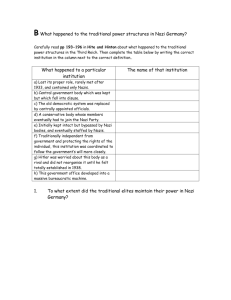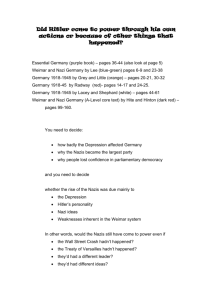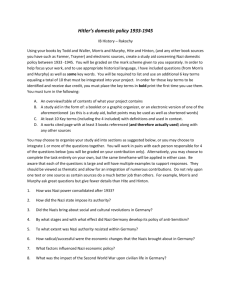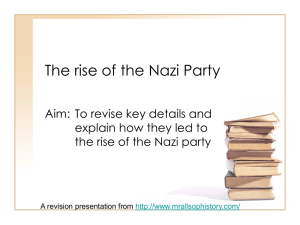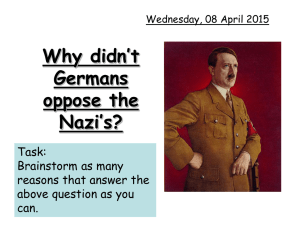Document
advertisement
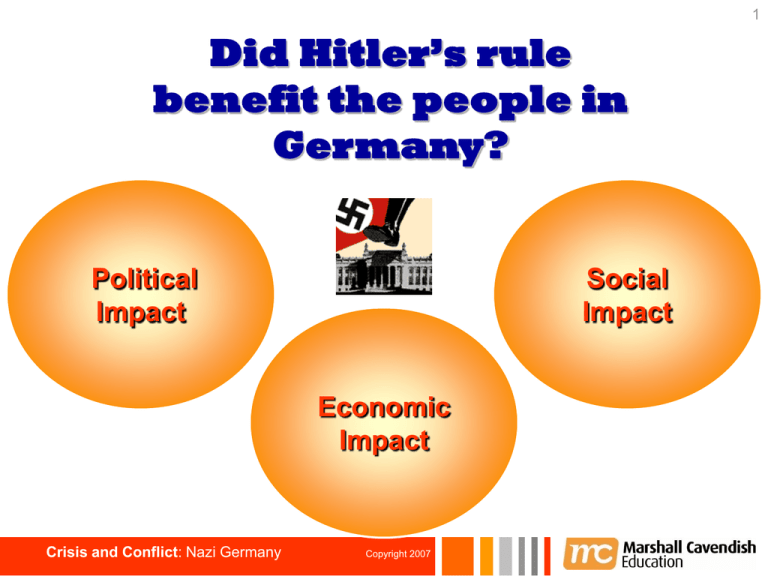
1 Did Hitler’s rule benefit the people in Germany? Political Impact Social Impact Economic Impact Crisis and Conflict: Nazi Germany Copyright 2007 2 Political impact Hitler consolidated power and established dictatorship from 1933-1934. 4 key steps: Reichstag Fire (Feb 1933) Enabling Act (March 1933) Night of Long Knives (June 1934) Creation of role of Fuehrer (Aug 1934) Crisis and Conflict: Nazi Germany Copyright 2007 3 Reichstag Fire (Feb 1933) Hitler called for fresh elections to gain control of Reichstag. In Feb 1933, the Reichstag building caught fire; a communist was caught red-handed. Crisis and Conflict: Nazi Germany Copyright 2007 4 Reichstag Fire (Feb 1933) Hitler convinced Hindenburg to grant him emergency powers to arrest Communists and other opponents. Reichstag Fire decree – all civil rights suspended – no freedom of speech, assembly, or press Result? Nazis won 44% of the votes in the election and gained more seats in Parliament. Crisis and Conflict: Nazi Germany Copyright 2007 5 Crisis and Conflict: Nazi Germany Copyright 2007 6 Enabling Act (March 1933) Using the SA, Hitler intimidated the Reichstag into passing the Enabling Act in March 1933 This act gave Hitler full dictatorial powers for four years. He could make his own laws without consulting the Reichstag or the President Crisis and Conflict: Nazi Germany Copyright 2007 7 Source A: A member of the opposition recalling the day in the Reichstag when the Enabling Act was passed We could not agree with what Hitler was asking for and we expressed our disapproval but that did us no good. Hitler’s supporters surrounded us in a semi-circle along the walls of the Reichstag, hissed loudly and murmured, ‘Shut up! Traitors! You all will be hung today.’ Crisis and Conflict: Nazi Germany Copyright 2007 8 Enabling Act (March 1933) May 1933: All trade unions were dissolved. July 1933: All other political parties were banned. Impact: established one-party dictatorship in Germany; democracy destroyed. Crisis and Conflict: Nazi Germany Copyright 2007 9 Night of the Long Knives (June 1934) By 1934, the SA had grown into a four-million strong army under Ernst Rohm wanted to turn SA into a second German Army Alarmed the generals and Hitler saw SA as a threat Crisis and Conflict: Nazi Germany Copyright 2007 10 Source B: Extracted from a conversation in 1934 with Rohm ‘Hitler is a pig, he will betray us all. He only mixes with posh people now. His old friends are not good enough for him. He knows what I want, and it isn’t to turn the SA into a branch of the army. Are we revolutionaries or aren’t we? Why is he getting friendly with the generals? I can be the creator of a new army.’ Crisis and Conflict: Nazi Germany Copyright 2007 11 Night of the Long Knives (June 1934) In June 1934, Hitler arrested and executed Rohm and many SA leaders. The killings were known as Night of the Long Knives. Impact: destroyed opposition within Nazi party; gained support of the military Crisis and Conflict: Nazi Germany Copyright 2007 12 Crisis and Conflict: Nazi Germany Copyright 2007 14 Created the role of Fuehrer (Aug 1934) Aug 1934: President Hindenburg died Hitler made himself President as well as Chancellor, creating a new role called the ‘Fuehrer’ supreme, unchallenged powers Armed forces had to swear an oath of loyalty to him. Impact: made him absolute ruler of Germany Crisis and Conflict: Nazi Germany Copyright 2007 15 The Fuehrer Oath I swear by almighty God this sacred oath: I will render unconditional obedience to the Fuehrer of the German Reich and people, Adolf Hitler, Supreme Commander of the Wehrmacht. Ba ck Crisis and Conflict: Nazi Germany Copyright 2007 16 SEQ practice Why did Hitler completely control Germany by late 1934? EYA. (2005 ‘O’ level) Crisis and Conflict: Nazi Germany Copyright 2007 17 Evaluation of political impact Positive effects Crisis and Conflict: Nazi Germany Negative effects Copyright 2007 18 Economic impact Economy improved in general compared to Weimar rule Nazis controlled vital aspects of economy Crisis and Conflict: Nazi Germany Copyright 2007 19 Increased employment Hitler introduced several policies to create jobs: public works programmes such as building of roads, motorways (autobahns), hospitals etc. – provided jobs and infrastructure conscription and rearmament removal of Jews/ women from public sector Overall unemployment fell from six million in 1933 to below one million in 1939. Crisis and Conflict: Nazi Germany Copyright 2007 20 Crisis and Conflict: Nazi Germany Copyright 2007 21 Militarization Rearmament created new jobs - manufacturing arms, supplying raw materials and military equipment e.g. creation of modern air force The introduction of conscription in 1935: every man aged between 18 and 25 had to spend two years in the armed forces – reduced unemployment. Crisis and Conflict: Nazi Germany Copyright 2007 22 Based on this illustration, what was the strength of the German economy based on? Ba ck Crisis and Conflict: Nazi Germany Copyright 2007 23 Organizing workers’ leisure time efforts were made to improve lives of workers e.g. ‘Strength through Joy’ (Kdf) scheme provided cheap theatre trips, cruises and sporting activities for workers. e.g. ‘Beauty of Labour’ scheme to improve working conditions – washing facilities and low-cost canteens e.g. popular scheme to help workers buy a Volkswagen Beetle car for a small weekly payment Crisis and Conflict: Nazi Germany Copyright 2007 24 Crisis and Conflict: Nazi Germany Copyright 2007 25 Crisis and Conflict: Nazi Germany Copyright 2007 26 Workers were tightly controlled German Labour Front (DAF) set up to keep strict control of workers e.g. not allowed to strike or bargain for higher wages e.g. not allowed to change their jobs without government permission. In 1935 a wage freeze was imposed. By 1939, as the economy geared up for war, workers were working up to 72 hours a week. Crisis and Conflict: Nazi Germany Copyright 2007 27 Big businesses benefited Big businesses benefited from Nazi policies Goering’s Four-Year Plan (1936): prepare for war by producing arms and ensuring that country was selfsufficient. Big companies gained huge government contracts to produce weapons and war materials (steel, oil etc.) No longer had to worry about troublesome trade unions and strikes Crisis and Conflict: Nazi Germany Copyright 2007 28 Evaluation of economic impact Positive effects Crisis and Conflict: Nazi Germany Negative effects Copyright 2007 29 Social impact Hitler imposed tight control over the people in order to achieve his goals. German people had little freedom. Some groups suffered discrimination and persecution. Crisis and Conflict: Nazi Germany Copyright 2007 30 Propaganda Joseph Goebbels controlled the Propaganda Ministry, which aimed to brainwash people into obeying Nazis and idolizing Hitler Cult of personality – Hitler’s picture was everywhere and he was portrayed as Germany’s saviour Crisis and Conflict: Nazi Germany Copyright 2007 31 Propaganda Radio stations were controlled to broadcast Hitler’s speeches and Nazi propaganda. All films had to carry pro-Nazi message praised the Nazis or showed the Jews as enemies Nuremberg rallies: spectacular rallies that gave an impression of power and unity Crisis and Conflict: Nazi Germany Copyright 2007 32 Crisis and Conflict: Nazi Germany Copyright 2007 33 1936 Olympics Propaganda opportunity to showcase Germany as a modern and successful nation Germany came top of medal table Projected efficiency, power, strength and achievement Crisis and Conflict: Nazi Germany Copyright 2007 34 Crisis and Conflict: Nazi Germany Copyright 2007 35 Censorship The Nazis controlled all forms of media and there was very strict censorship. Newspapers could publish only what was approved by the Ministry of Propaganda. Books written by Jews and other ‘undesirable’ people were removed from libraries and burnt in public. Crisis and Conflict: Nazi Germany Copyright 2007 36 Censorship Only Nazi-approved artists could show their works – usually paintings or sculptures of heroiclooking Aryans or images of ideal Aryan family Music was controlled. Jazz was banned as it had been invented by black people Crisis and Conflict: Nazi Germany Copyright 2007 37 Crisis and Conflict: Nazi Germany Copyright 2007 38 Crisis and Conflict: Nazi Germany Copyright 2007 39 Crisis and Conflict: Nazi Germany Copyright 2007 40 The SS and the Gestapo Instruments of terror Arrested and killed opponents of the Nazi Party The SS (Elite Guard): responsible for destroying opposition to Nazism and carrying out racial policies of Nazis. The Gestapo (secret police): ruthless organization that could arrest and send people to concentration camps without trial Crisis and Conflict: Nazi Germany Copyright 2007 41 Crisis and Conflict: Nazi Germany Copyright 2007 42 Informers The Nazis appointed Blockleiter (block leader) to spy on the population and report any anti-Nazi activities to the local Gestapo office. People were encouraged to report on their families and neighbors who did not show total support for Hitler and the Nazi Party. Crisis and Conflict: Nazi Germany Copyright 2007 43 Concentration camps Established in 1933; run by SS. Opponents of the Nazis and undesirable members of the population, such as Jews, Communists and gypsies, were sent to the camps without trial. Prisoners forced to do hard labour; given limited food; suffered beatings and random execution Very few emerged alive Crisis and Conflict: Nazi Germany Copyright 2007 44 Crisis and Conflict: Nazi Germany Copyright 2007 45 Education and youth Schools encouraged loyalty and obedience to Nazism. Textbooks were re-written to include Nazi political and racial ideas e.g. Treaty of Versailles was unfair Superiority of the Germans as Aryan race Jews were subhuman; depicted as ugly and greedy Crisis and Conflict: Nazi Germany Copyright 2007 46 Education and Youth Nazi youth organizations were set up for both sexes. Hitler Youth: used physical and military training to indoctrinate boys to glorify war League of German Maidens: taught girls to welcome their role as mothers Crisis and Conflict: Nazi Germany Copyright 2007 47 Why children are important When an opponent declares, “I will not come over to your side,” I calmly say, “Your child belongs to us already… What are you ? You will pass on. Your descendants, however, now stand in the new camp. In a short time they will know nothing else but this new community.” Crisis and Conflict: Nazi Germany Copyright 2007 48 What I can see Key Questions Hitler in the background Who is this poster aimed at? Young HJ boy. Aryan in appearance, serious, looking ahead (in awe?) Why was this poster produced? What does this poster tell you about Nazi attitude towards youth? Military/ Smart Uniform Caption in Bold “Youth Serves the Führer” All 10-year-olds into the Hitler Crisis and Conflict: Nazi Germany Youth." Copyright 2007 49 “Adolf Hitler's youth attends community schools” Crisis and Conflict: Nazi Germany Copyright 2007 50 Crisis and Conflict: Nazi Germany Copyright 2007 51 Nazi-controlled education system: The Nazis had total control over the subjects and textbooks. The main objective of education was to teach Nazi ideas and to instill in all young Germans a sense of loyalty to Nazism. Crisis and Conflict: Nazi Germany Copyright 2007 52 Use of terror to control Germany: The Nazis used violence to make sure that they did not face challenges to their power. Many opponents of the Nazis were beaten up, sent to prison or killed. Crisis and Conflict: Nazi Germany Copyright 2007 53 Women were given limited responsibilities Nazis believed that women should only be concerned about ‘children, church, cooking’. Their role was to produce racially pure and healthy German babies and to look after their families. Crisis and Conflict: Nazi Germany Copyright 2007 54 Women were given limited responsibilities Many professional women were forced to give up their jobs and stay at home. Women who bore many children received special awards and cash incentives. Crisis and Conflict: Nazi Germany Copyright 2007 55 Critical Thinking These statements were on a Nazi leaflet given to all young women. Do you agree with the statements? 1. Remember that you are a German! 2. If you are healthy, do not stay single! 3. Keep your body pure! 4. Keep your mind and spirit pure! 5. Marry only for love! 6. As a German, choose only a husband of the same blood! 7. In choosing a husband, ask about his forebears! 8. Health is essential to beauty! 9. Don’t look for a playmate but for a companion! 10. You should want to have as many children as possible! Crisis and Conflict: Nazi Germany Copyright 2007 The Cross of Honor for the German mother bronze for four to five children silver for six to seven children gold for eight or more children. Crisis and Conflict: Nazi Germany Copyright 2007 56 57 Persecution of Jews Hitler and the Nazis believed that Germans belonged to the superior Aryan race while the Jews were the inferior race (Untermensch). Inferior races should be the slaves of the superior race When the Nazis came to power, they immediately began to take measures against the Jews. Crisis and Conflict: Nazi Germany Copyright 2007 58 Persecution of Jews 1933 1935 • All Jews were sacked from government jobs. • The Nuremberg Laws were passed. • The government called for the boycott of Jewish shops. • Jews were stripped of their German citizenship and banned from marrying Germans. Crisis and Conflict: Nazi Germany Copyright 2007 1938 • Jews were not allowed to attend state schools and universities. • Jews were banned from owning businesses. 59 Crisis and Conflict: Nazi Germany Copyright 2007 60 Crisis and Conflict: Nazi Germany Copyright 2007 61 Night of Broken Glass On 7 November 1938, following the killing of a German official by a Jew, the Nazis organized a night of violence against the Jews. More than 7 500 Jewish shops and over 400 synagogues were destroyed. 91 Jews were killed; 20,000 taken to concentration camps. Crisis and Conflict: Nazi Germany Copyright 2007 62 Holocaust • ‘Final Solution’ which killed more than 6 million Jews through death extermination camps in parts of Germany and Poland. Crisis and Conflict: Nazi Germany Copyright 2007 63 Crisis and Conflict: Nazi Germany Copyright 2007 64 ‘ALL THAT IS NEEDED FOR EVIL TO SUCCEED IS, THAT DECENT HUMAN BEINGS DO NOTHING’. (Edmund Burke) Crisis and Conflict: Nazi Germany Copyright 2007 66 Other groups persecuted by Nazis Nazis believed that people with disabilities were genetic degenerates. The Nazis, therefore: Killed mentally disabled babies and mentally ill patients. Sterilized physically disabled people Crisis and Conflict: Nazi Germany Copyright 2007 67 This genetically ill person will cost our people's community 60,000 marks over his lifetime. Citizens, that is your money. Crisis and Conflict: Nazi Germany Copyright 2007 68 Christian churches were controlled by Nazis Hitler set up a state Reich Church, which preached Nazi values, and banned the Bible and the cross. All church schools and youth groups were closed. Priests and pastors who opposed the Nazi party were arrested and sent to concentration camps. Ba ck Crisis and Conflict: Nazi Germany Copyright 2007 69 Crisis and Conflict: Nazi Germany Copyright 2007 70 Letter writing Imagine you were the leader of the League of Nations in 1938. Write a formal letter to Hitler of Nazi Germany. Persuade him to reform the government policies that are bringing more harm than benefits to the German people. The length of your letter should be about 250 to 300 words. Crisis and Conflict: Nazi Germany Copyright 2007 Summary Impact of Hitler’s regime Political Social Economic • Working conditions partly improved. • New jobs were created. • Big business benefited. Crisis and Conflict: Nazi Germany Back to main summary • Democracy in Germany ended. • Threats to Hitler within the Party were removed. • Emergency laws were used. • The SS and the Gestapo. • Informers. • Concentration camps. • Pro-Nazi cultural activities, parades and rallies. • Propaganda and censorship. • Youths were brainwashed by the Nazis. • Nazi-controlled education system. • Women were given limited responsibilities. • Jews were treated cruelly. • Christian churches were controlled by the Nazis. Copyright 2007 71
